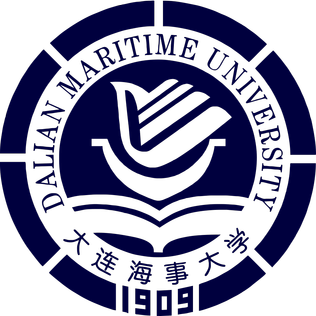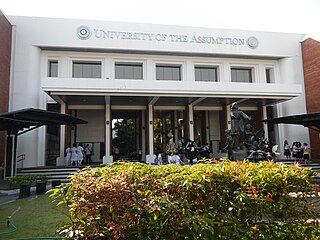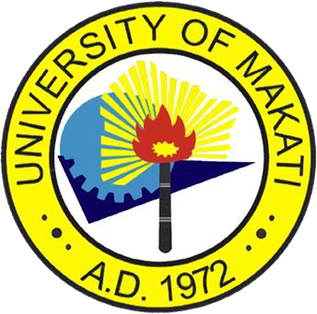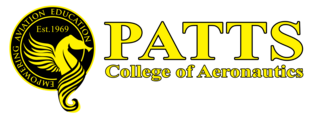
The University of the Philippines Diliman, also referred to as UP Diliman or simply University of the Philippines (UP), is a public, coeducational, research university located in Diliman, Quezon City, Philippines. It was established on February 12, 1949, as the flagship campus and seat of administration of the University of the Philippines System, the premier and national university of the Philippines.

Dalian Maritime University is a public university in Dalian, Liaoning, China. It is affiliated with the Ministry of Transport. The university is part of the Double First-Class Construction.

The University of San Carlos is a private, Catholic, research, coeducational basic and higher education institution administered by the Philippine Southern Province of the Society of the Divine Word missionaries in Cebu City, Philippines, since 1935. It offers basic education and higher education. Founded originally in 1595 as Colegio de San Ildefonso which was closed upon the expulsion of the Jesuit missionaries from the Philippines in 1768. The Colegio was reopened in 1783 as Seminario-Colegio de San Carlos until the colegio was split from the seminary in 1924. The Colegio de San Carlos became university on July 1, 1948.

Mapúa University, also known simply as Mapúa or MU, is a private research-oriented non-sectarian university located in Metro Manila, Philippines. The university was founded in 1925 by the first registered Filipino architect, Tomás Mapúa, a graduate of Cornell University in New York, US. In 2000, the university was acquired by the Yuchengco Group of Companies.

The University of the Assumption (U.A.) is a private archdiocesan Catholic university in the City of San Fernando, Pampanga, Philippines. The University of the Assumption is the first Catholic archdiocesan university in the Philippines and in Asia. It is among the top schools in the region, based on its accredited programs, and licensure and professional examination results.

The PHINMA – University of Iloilo is a private, nonsectarian, coeducational institution in Iloilo City, Philippines. It was established in 1947 by the López family of Iloilo who founded the broadcasting giant ABS-CBN Corporation as Iloilo City Colleges. The university was later acquired by the business conglomerate group PHINMA Industries, and its current operations and management is controlled by the said company under its arm, PHINMA Education Network.
Education in the Philippines is compulsory at the basic education level, composed of kindergarten, elementary school, junior high school, and senior high school. The educational system is managed by three government agencies by level of education: the Department of Education (DepEd) for basic education; the Commission on Higher Education (CHED) for higher education; and the Technical Education and Skills Development Authority (TESDA) for technical and vocational education. Public education is funded by the national government.
Klaipėda University is a university in the Lithuanian port city of Klaipėda.

Philippine Merchant Marine Academy is a maritime higher education institution operated by the Philippine government in San Narciso, Zambales. Students are called midshipmen but are often also referred to as cadets. Upon graduation, students are commissioned as ensigns in the Philippine Navy Reserve and have the option to join the merchant marine, the Philippine Navy, or the Philippine Coast Guard.

San Juan de Dios Educational Foundation, Inc. is a private, non-stock, non-profit, joint institute of education and tertiary health sciences operating as a college and a hospital in Pasay, Philippines. Both the colleges and hospital are run by the Daughters of Charity. It started out as a hospital in 1578. The hospital is considered the oldest hospital in the Philippines. It is named after San Juan de Dios, a Portuguese-born soldier that turned health-care worker of Spain.

The Palompon Institute of Technology (PIT) is a state college in Leyte, Philippines. It is mandated to provide higher vocational, professional, and technical instruction and training in trade and industrial education and other vocational courses, professional courses, and offer engineering courses. It is also mandated to promote research, advance studies and progressive leadership in the fields of trade, technical, industrial and technological education. Its main campus is in Palompon, Leyte.

The University of Makati, commonly referred to as UMak, is a public, non-sectarian higher education institution in Taguig, Philippines, owned and operated by the City of Makati. It was founded in 1972 by the Makati government as the Makati Polytechnic Community College by virtue of Municipal Resolution No. 242 Ordinance No. 64.

Capitol University is a non-sectarian, co-educational private university located in Cagayan de Oro, Philippines. It is registered with the Securities and Exchange Commission as a stock corporation and operates with the authority of the Department of Education for its primary and secondary programs and the Commission on Higher Education for its tertiary, graduate and postgraduate programs.

PATTS College of Aeronautics, also known as Philippine Air Transport and Training Services, is an aeronautical school at Lombos Ave., Brgy. San Isidro, Parañaque, Metro Manila, Philippines. It was founded by Atty. Ambrosio R. Valdez Sr.

The Polytechnic State University of Bicol (PSUB) is a state university in Nabua, Camarines Sur, Philippines. It is mandated primarily to provide higher technological, professional and vocational instruction and training in fisheries, trade, as well as short term technical and vocational courses, as the Board of Trustees may deem necessary, and shall promote research in the exploration and conservation of natural resources in the province. Its main campus is located in Nabua, Camarines Sur.
The Angeles University Foundation also referred to by its acronym AUF, is a private Roman Catholic non-stock, non-profit educational institution run by lay persons in Angeles City. It was established on May 25, 1962, by Agustin P. Angeles, Barbara Yap-Angeles, and their family.

PMI Colleges, formerly known as Philippine Maritime Institute, is a private, non-sectarian, co-educational higher education, Maritime institution established on September 18, 1948 in Santa Cruz, Manila, Philippines where its main campus is located.

Far Eastern University, also referred to by its acronym FEU, is a private research non-sectarian university in Manila, Philippines. Created by the merger of Far Eastern College and the Institute of Accounts, Business and Finance, FEU became a university in 1934 during the term of its first president, Nicanor Reyes Sr.

PNTC Colleges, formerly known as Philippine Nautical and Technological College, is a private, non-sectarian Higher Education Institution (HEI) and a Maritime Training Institution (MTI) in the Philippines.
The University of Cagayan Valley (UCV) is a private, non-sectarian university located in Tuguegarao, Cagayan, Philippines. It was formerly known as Cagayan Teachers College and Cagayan Colleges Tuguegarao.
































